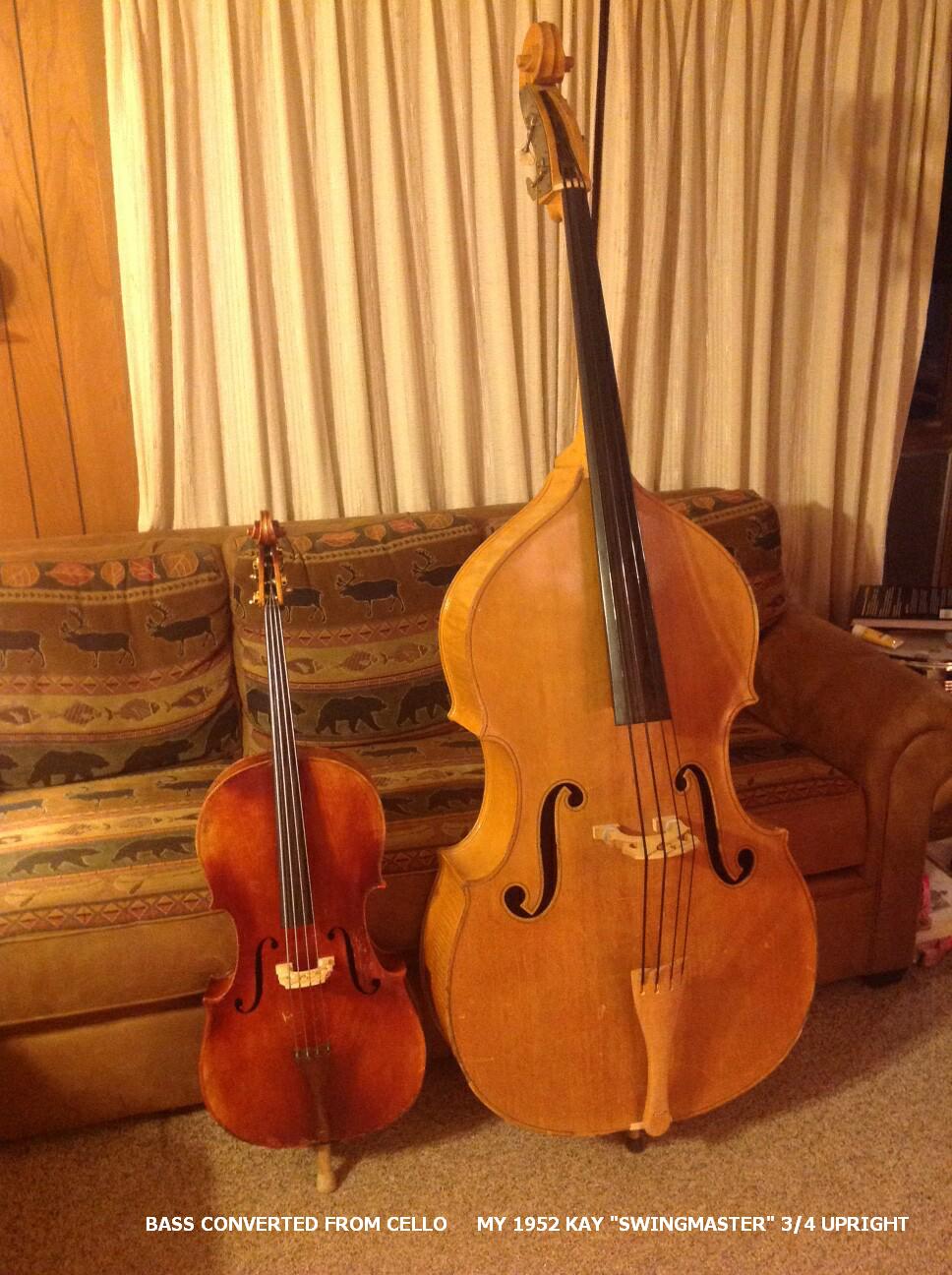Easily convert a cello into a very nice mini-bass that
has the same notes and octave as a big honker upright bass
& plays/sounds great.
I was given an old student-grade 1/2 size cello recently &
not playing the cello, I set about on the quite simple task
of converting it into a bass.
I've read a bit about doing just this but it seems the web
folks who've attempted the conversion must be using the wrong
strings and don't seem satisfied with the results. I myself
am very surprised & very happy with the tone, volume and ease
of playing this converted instrument. It's a LOT of fun to
play & a heck of a conversation piece.
A little bit later note after a few days playing this little
thing: Over the years I've made and converted hundereds of
instruments. There never has been any sort of guarantee that an idea
would pan out - in short, I have a special shelf in the garage
for ones that didn't! Duds, failures. This cello to bass conversion
is certainly not one of these duds --- I absolutely - absolutely
LOVE it! -- so much so that I'm on the lookout for another cello
to convert for friends. It's SO easy to play - just to sit back
& accompanying music with it held like a guitar is a joy!

The actual conversion is a no-brainer:
- Replace the strings
- Enlarge the string grooves in both the bridge and nut - if needed
- Enlarge the string holes in the tuning pegs - if needed
- Retune to EADG (low to high) in the same octave as a big upright bass.
Fender flat-wound 9050L electric bass strings are THE KEY to success
here -- they work absolutely perfectly & cost $22.35 from elderly.com
in early 2013). I first tried an old set of round-wound electric bass
strings which, altho the tone was nice, created an intolerably loud
"scratch" whenever you wanted to slide into a note - in contrast, the
flat-wounds are smooth as silk and virtually silent when sliding.
Do not use round-wounds. I also experimented with weed-whip nylon line
in gauges up to .130 inch with poor results. USE THE FENDER FLAT-WOUNDS!
When I resuscitated my badly beat-up cello which came with no tuning
pegs, I used inexpensive Grover knock-off guitar tuners ($16 a set)
which easily handle the reduced tension of the shortened Fender strings.
I had to enlarge most of the tuner's string-holes to accommodate the
fatter new strings. I unraveled some of the string's outer windings
for a half an inch at the ends so as not to have to drill too large a
hole in the tuner shafts. The same issue will likely occur with regular
wooden friction pegs & is handled in the same manner.
Not owning proper nut/bridge files, I enlarged the grooves in the nut &
bridge in a few minutes using a combination of an exacto-knife, chain-saw
sharpening file, hacksaw blade & a bit of folded sandpaper. Dirty-up each
groove with a #2 pencil for lubrication.
A word about string-tension. This converted cello can easily handle the
new, thicker strings for this reason: the string-length on a 1/2 size
cello is about 23 inches. The Fender flat-wound electric bass strings are
designed to be put on electric basses which have a string-length of
around 34 inches, so as you can see, to achieve the same bass pitch on
the converted cello, the strings are tuned considerably lower, slacker than
if mounted on an electric bass, negating any worry about taxing or breaking
the instrument. What surprised me was that, despite the lessened string
tension, they still made for a fine tone and decidedly non-flabby feel
on the mini-bass! No complaints at all. The same Fender flat-wound
strings should work fine if used on a full-size cello, the string-length
still being a lot shorter than on an electric bass.
Please let me know if you make this conversion.
Dennis Havlena - W8MI
February 13, 2013
northern Michigan
dhavlena@gmail.com
DennisHavlena.com
Click here to access
my webpage
keywords: bass cello conversiion convert make build havlena cheboygan upright half size
